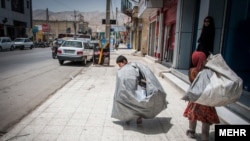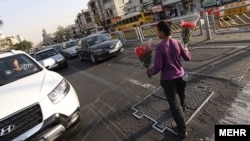Approximately nine thousand child laborers in Iran, many of whom homeless and vulnerable to violence and sexual abuse, have been identified and given shelter, according to top officials in the Islamic Republic.
“Child workers are so numerous that no organization can single-handedly cope with the problem,” said the director of the Iran Welfare Organization’s Office of Social Harm Victims, Reza Jafari.
Speaking to state-run Iran Labor News Agency (ILNA) April 25, Jafari said the child workers, who either labor in underground workshops or are sent out into the streets by their families to beg, are “deprived of all human rights.”
Official Iranian estimates going back a decade put the number of homeless children at 60,000, though many children’s rights organizations believe the number is much higher, estimating up to 200,000 children or more sleep on the streets.
In a shocking comment made last October in an interview with state-run Iran Students News Agency (ISNA), the managing director of the Tehran Social Services Organization, Reza Ghadimi, claimed that based on a survey of 400 child laborers, 90 percent of them are “molested.”
After his statement caused uproar, Ghadimi later backtracked, saying he was not referring to sexual abuse.
“By molesting, I did not mean sexual abuse of the working children. I meant child workers are left in the cold, outside in the streets, they are not fed properly, and their faces are painted black to attract pity,” Ghadimi said.
However, the daily Shahrvand reported it has an audio recording of Ghadimi’s initial remarks, in which he clearly states that 90 percent of child laborers are “sexually abused.”
Other government officials maintain Ghadimi’s 90 percent claim is unfounded.
Jafari said the problem of homeless children and child labor is so massive, Iran’s Welfare Organization (IWO) cannot cope and needs assistance from other government institutions and NGOs.
“As the child workers are deprived of schooling, their future will be as dim as today” said Jafari, insisting that education should be the top priority in any plan devised to save these children and adolescents from the deplorable condition they are living in.
In November 2017, Interior Minister Abdolreza Rahmani Fazli also insisted on the necessity of educating child laborers.
Announcing new guidelines for “managing of the street children issue,” Fazli promised to “round-up the street children” and send them to schools and other “centers” to be educated and trained.
His plan triggered a barrage of criticism on social media, in parliament, and in Tehran’s city council.
The solution of “rounding up street children” has already been tried 30 times without any success, noted the chairman of the board of the Iranian Society for Protecting Children’s Rights, Motahareh Nazeri. The plan’s opponents argue getting children off the streets is impossible without systemic social and economic change.
Another aspect of the plan that has been widely criticized by activists and lawyers is the rule that children found begging or unsupervised on the streets for the third time will be removed from their parents’ custody.
According to United Nations Office on Drugs and Crime (UNODC), “In Iran, children living on the streets can often be seen in urban centers such as Tehran, Isfahan, Mashhad, and Shiraz. Many of them are the offspring of Afghan refugees. Others come from Iranian families who have slipped, through unemployment, drug addiction, or illness, into the populous ranks of the urban poor.”
Iran is a signatory to the Convention on the Rights of the Child, but it has not ratified other international conventions defining the minimum age for child labor. Nonetheless, according to Iranian law, a child cannot legally work under the age of fifteen.





